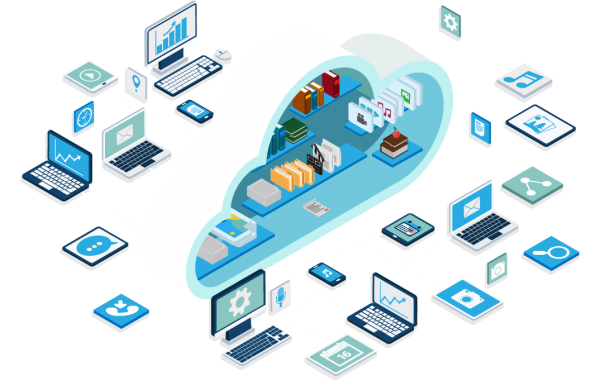As it is well-known nowadays, traditional business indicators don’t account for all key factors that impact the profitability of a SaaS platform to their fullest extent. In the SaaS world, there are several variables that are crucial for future results. So, today we’ll cover top SaaS sales metrics and how to track them if you are the business owner.
What is SaaS?
SaaS stands for ‘software as a service’. SaaS is a model for providing the license for using the software on a subscription basis. Mostly, such solutions are cloud-based – users access the service via a browser or API. The support of SaaS solutions falls completely under the service provider’s responsibility.
So, put in simple terms, the SaaS sales model allows the user to work with a ready-to-use solution online after paying a subscription fee.
Why You Should Analyze SaaS Metrics
So, what are sales metrics? Put in simple terms, these are the figures that help you evaluate the following aspects of your business:
- Is your business economically viable?
- What works well and what should be improved?
- What leverages should you focus on?
- When the CEO should speed up or slow down the development of the business?
Does any SaaS business have to use metrics? Or, perhaps, in certain cases, they are not that obligatory at all?
Generally speaking, the more complex your sales funnel is and the more customers your business has, the harder it becomes to track ROI. Of course, there is no point to calculate LTV if all of your ten clients paid for your services to the fullest extent. And it can be vice versa – it is only by analyzing the sales metrics for SaaS that you can find out what issues you should focus on in order to ensure your business growth. So, some (or all) metrics on our list will help you understand how your business is doing and what you should concentrate your efforts on.
10 Key SaaS Metrics Sales Teams Should be Using
So, now that you’re convinced that keeping track of SaaS metrics is crucial, let’s take a look at 10 main SaaS sales metrics that will help you determine how profitable your business is.

Lead Velocity Rate (LVR)
Lead Velocity Rate is the qualified lead growth rate per month. The advantage of this indicator is that it gives you a clear understanding of future revenues and growth. This understanding is more important than knowing the revenue growth rate per month or quarter.
For instance, if you set an aim to increase LVR by 20%, you’ll be able to increase your revenue as well. Unlike sales indicators, LVR stand out thanks to its comparative stability – lead generation doesn’t work like clockwork, though, but neither do sales.
LVR calculation formula is as follows:
[Qualified Leads This Month – Qualified Leads Last Month]/[Qualified Leads Last Month]*100
As a result, you’ll get the growth rate for new leads per month.
Conversion Rate
The term ‘conversion’ is used for every target action that a future user of your SaaS solution has to take. These actions may include anything from establishing contact with the potential user (by him or her subscribing to the email newsletter, downloading free materials, or making a phone call) to him or her paying the subscription fee. Calculating this metric will help you check the efficiency of your current sales funnel. Besides, it allows understanding which strategies bring you the highest profits.
The conversion rate is calculated using the following formula:
[Total Number of Sales]/[Number of Leads]*100
If your saas sales funnel consists of many substeps, and all the stages are not inseparable (i.e., they take place in separate time periods that are long enough), we advise you to calculate this metric for every stage separately.
Monthly Recurring Revenue (MRR)
MRR (Monthly Recurring Revenue) is the backbone of any SaaS business that, in fact, determines its attractiveness in the eyes of entrepreneurs and investors. You don’t have to worry about sustaining the needed level of one-time sales – all the charges are made automatically in the form of a monthly subscription fee.
As for MRR and its purpose, this sales metric averages all your subscription plans and calculation periods and puts them into one common indicator – and tracking its changes with time is easier than following the changes in a number of metrics and understanding which of them are severe and which ones are not.
This metric is calculated using the following formula:
[Number of Clients]*[Amount of Your Monthly Revenue]
Average Revenue Per User (ARPU)
ARPU (average monthly recurring revenue per user) is one of the most precious metrics. It allows determining the tendencies and implementing changes to get your business closer to high profits.
ARPU reflects how much your user spends on your product per month on average. If you calculate this metric properly, you’ll be able to determine the preferences of each client group based on what they purchased in the past. If you visualize the calculation results in a chart, you’ll be able to pinpoint the most popular price ranges and upselling trends.
ARPU is calculated as follows:
[Total MRR]/[Total Customers]
Customer Lifetime Value (LTV)
Acquiring a new customer will cost you five to seven time more than retaining an existing one. If you want to act on this information, you will find the LTV (Customer Lifetime Value) metric helpful. In its essence, this saas metric reflects the total revenue that a customer brings you over the whole period of your company’s relationship with him or her.
If you calculate it properly, you will see how much your customers spend, how often they make purchases, what programs and bonuses they are interested in – and the latter can encourage them to become regulars. Besides, taking into account the Customer Lifetime Value when calculating the Return on Investment (ROI) will help you see the whole picture of your business’ profitability and how you can manage it.
The basic formula for calculating LTV is as follows:
[Average Order Cost]*[Number of Purchases]*[Loyalty Period]
Customer Acquisition Cost (CAC)
САС, or Customer Acquisition Cost, consists of the marketing and sales costs. Put in simple terms, CAC is the total cost of all marketing efforts that are required for engaging one new customer.
This indicator reflects whether your company has a viable business model that allows keeping a low level of CAC while scaling up your business activities. However, CAC tends to rise constantly due to launching new marketing campaigns and employing new promotion techniques.
The formula for calculating CAC is as follows:
[Marketing Expenses over a Certain Period of Time]/[Number of New Customers over a Certain Period of TIme]
Cumulative Cohort Revenue (CCR)
Instead of САС, some companies use another formula to understand customer value. They tend to track a metric called Cumulative Cohort Revenue (CCR). It is the total amount of revenue received from the customers acquired by the company over a certain period of time (usually it is 12 or 24 months).
Unlike CAC, this formula includes a period of time. This guarantees that you compare your current total revenue from one particular cohort with the amount that you spent on acquiring it. So, this leaves no place for false conclusions, and you know for sure under what circumstances you reach the break-even point.
CCR per year is calculated as follows:
[CCR for a Cohort in the 12th Month]/[Total Amount of Sales and Marketing Costs in the First Month for the Said Cohort]
Customer Churn Rate
Customer churn is the loss of clients reflected in the absence of purchases or payments over a certain period of time. This term applies to the lines of businesses where purchases are made regularly. This is why this metric is crucial for companies with subscription and transaction business models (and SaaS belongs in this category).
The Customer Churn Rate is not a very informative indicator on its own. You need to understand the churn structure itself:
- what client segments are the most prone to churn and why;
- what factors cause customer churn most often;
- what the churn dynamic and its structural tendencies are.
The formula for calculating the Customer Churn Rate is as follows (the result is a share):
[Number of Clients that Left by the End of the Month]/[Total Number of Clients that Paid for the Next Month]*100
Monthly Active Users (MAU)
The MAU metric reflects the number of active application users per month. To calculate this metric properly, you should count only the number of unique application users, not the number of user sessions.
Lead to Close Rate (LCR)
Last but not least on our list of the most important metrics, LCR will tell you how many people are ready to subscribe to your service in a certain period of time. Having done monthly calculations, you’ll be able to see how much of the targeted traffic you get and whether your sales department processes placed orders properly.
LCR is calculated in the following way:
[Number of Clients over a Certain Period]/[Total Number of Leads over a Certain Period]
3 Examples of SaaS Metrics in Use
Let’s take a quick look at three simple examples of calculating some of the metrics we described above:
- Example 1. The total number of your customers is 5,000. 200 of them unsubscribed from your services this month. Then, the Customer Churn Rate is 4%;
- Example 2. The total number of products sold in a month is 200 units, and the number of leads is 1,000. In this case, your Conversion Rate is 20%;
- Example 3. Your marketing costs amounted to $5,000 last month, and you acquired 500 new customers over that period of time. In this case, CAC is $10 per each client acquired.
3 Tips for Your Calculations
And now, let us give you three key recommendations for calculating and using the key metrics for SaaS:
- Be attentive. Although this tip may come off as a banal one, it still deserves your attention. For instance, some metrics described above can be calculated using different formulas, and your results will vary depending on the chosen formula. This can cause difficulties when you gather all the results into one report. So, be attentive.
- Check the formulas’ sources. Using the formulas to calculate sales metrics to track, make sure to check the formula you’ve chosen in several different sources;
- Figures are good, but it’s crucial to evaluate the whole picture. For instance, you shouldn’t expect a huge customer acquisition rate over a short period of time. And vice versa, if your product hasn’t become demanded over a year, it is likely to be economically unviable.
Conclusion

So, we’ve reviewed 10 key SaaS metrics and how to calculate and use them. As you can see, there are a lot of sales team metrics that you can use for your SaaS product to form with the most beneficial business strategy.
In case you are interested in promoting your SaaS product, reach out to us at Nimble – and we’ll help you implement your business strategy with pleasure.


